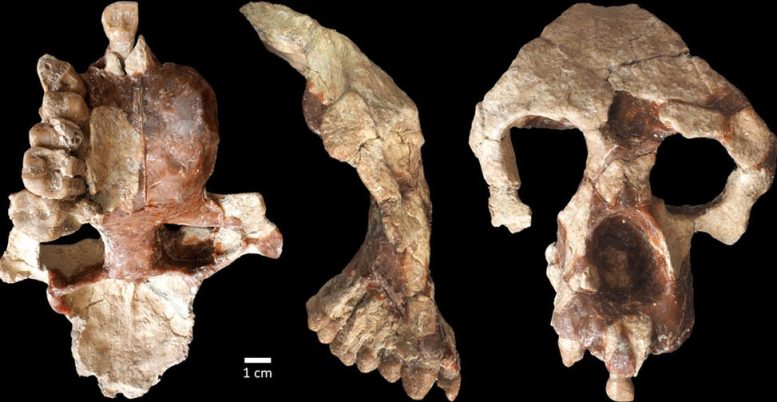
A new face and partial brain case of Anadoluvius turkae, a fossil hominine – the group that includes African apes and humans – from the Çorakyerler fossil site located in Central Anatolia, Türkiye. Credit: Sevim-Erol, A., Begun, D.R., Sözer, Ç.S. et al.
Anadoluvius existed nearly 9 million years ago and is ancestral to living African apes and humans.
A recent discovery of a fossilized ape from a site in Turkey, aged 8.7 million years, is challenging long-accepted ideas of human origins. This finding supports the hypothesis that the forebears of African apes and humans may have evolved in Europe and later migrated to Africa approximately 7 to 9 million years ago.
Analysis of a newly identified ape named Anadoluvius turkae recovered from the Çorakyerler fossil locality near Çankırı with the support of the Ministry of Culture and Tourism in Türkiye, shows Mediterranean fossil apes are diverse and are part of the first known radiation of early hominines – the group that includes African apes (chimpanzees, bonobos and gorillas), humans and their fossil ancestors.
The findings are described in a study recently published in Communications Biology co-authored by an international team of researchers led by Professor David Begun at the University of Toronto (U of T) and Professor Ayla Sevim Erol at Ankara University.
“Our findings further suggest that hominines not only evolved in western and central Europe but spent over five million years evolving there and spreading to the eastern Mediterranean before eventually dispersing into Africa, probably as a consequence of changing environments and diminishing forests,” said Begun, professor in the Department of Anthropology in the Faculty of Arts & Science at U of T. “The members of this radiation to which Anadoluvius belongs are currently only identified in Europe and Anatolia.”
The conclusion is based on an analysis of a significantly well-preserved partial cranium uncovered at the site in 2015, which includes most of the facial structure and the front part of the brain case.
“The completeness of the fossil allowed us to do a broader and more detailed analysis using many characters and attributes that are coded into a program designed to calculate evolutionary relationships,” said Begun. “The face is mostly complete, after applying mirror imaging. The new part is the forehead, with bone preserved to about the crown of the cranium. Previously described fossils do not have this much of the brain case.”
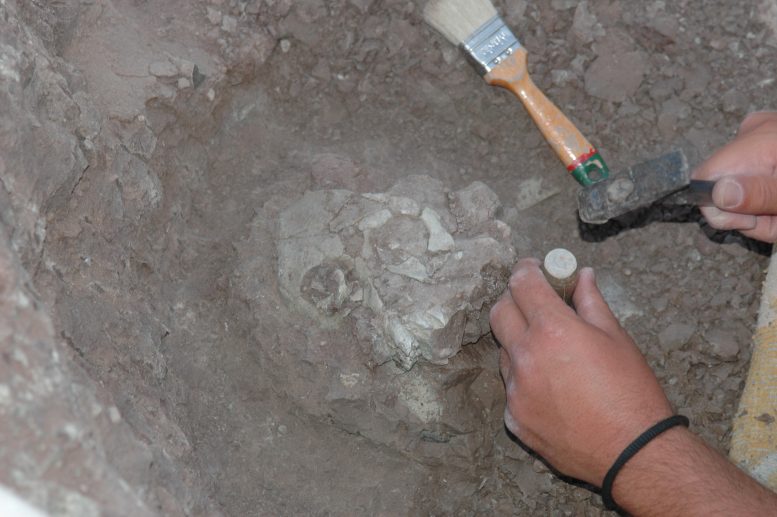
Excavation of the Anadoluvius turkae fossil, a significantly well-preserved partial cranium uncovered at the Çorakyerler fossil site in Türkiye in 2015. The fossil includes most of the facial structure and the front part of the brain case. Credit: Ayla Sevim-Erol
The researchers say Anadoluvius was about the size of a large male chimpanzee (50-60 kg) – very large for a chimp and close to the average size of a female gorilla (75-80 kg) – lived in a dry forest setting, and probably spent a great deal of time on the ground.
“We have no limb bones but judging from its jaws and teeth, the animals found alongside it, and the geological indicators of the environment, Anadoluvius probably lived in relatively open conditions, unlike the forest settings of living great apes,” said Sevim Erol. “More like what we think the environments of early humans in Africa were like. The powerful jaws and large, thickly enameled teeth suggest a diet including hard or tough food items from terrestrial sources such as roots and rhizomes.”
The animals that lived with Anadoluvius are those commonly associated with African grasslands and dry forests today, such as giraffes, wart hogs, rhinos, diverse antelopes, zebras, elephants, porcupines, hyaenas and lion-like carnivores. Research shows that the ecological community appears to have dispersed into Africa from the eastern Mediterranean sometime after about eight million years ago.
“The founding of the modern African open country fauna from the eastern Mediterranean has long been known and now we can add to the list of entrants the ancestors of the African apes and humans,” said Sevim Erol.
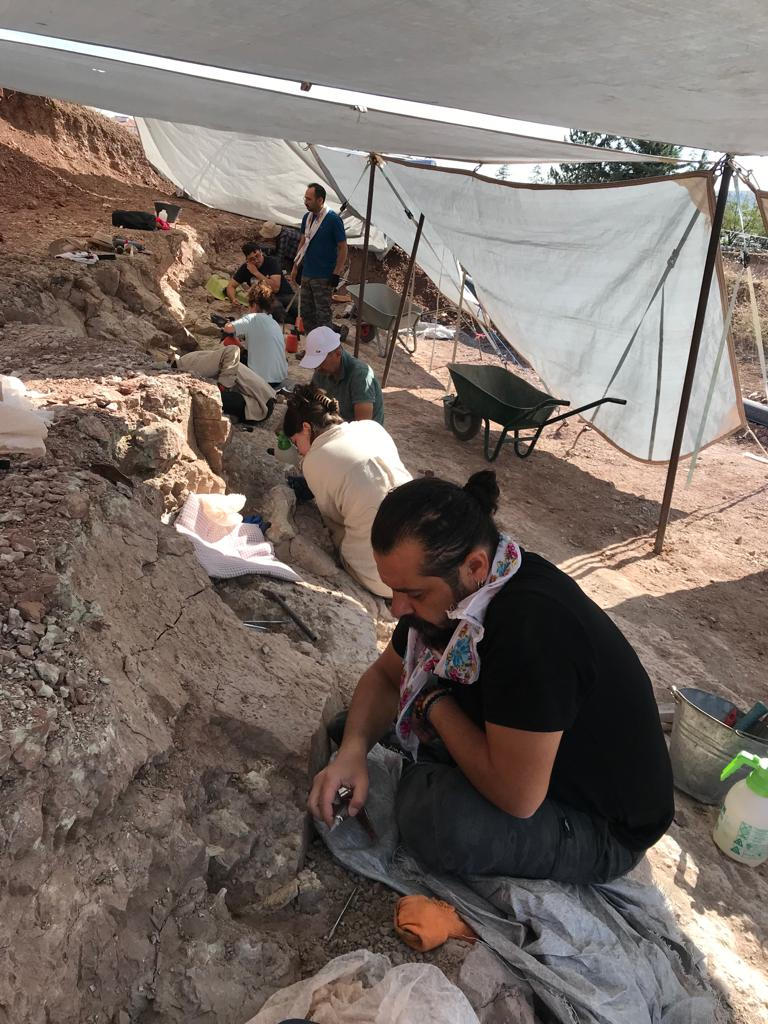
Çorakyerler excavation site. This vertebrate fossil settlement near Çankırı, Türkiye, is one of the most important humanoid settlements in Eurasia. As a result of nearly 20 years of excavations, Çorakyerlar has taken its place among the important Late Miocene reference localities of Anatolia and Europe with 8 mammalian orders, more than 10 families and 43 species. Credit: Ayla Sevim-Erol
The findings establish Anadoluvius turkae as a branch of the part of the evolutionary tree that gave rise to chimpanzees, bonobos, gorillas, and humans. Although African apes today are only known from Africa, as are the earliest known humans, the study’s authors – which also include colleagues at Ege University and Pamukkale University in Türkiye and the Naturalis Biodiversity Center in The Netherlands – conclude that the ancestors of both came from Europe and the eastern Mediterranean.
Anadoluvius and other fossil apes from nearby Greece (Ouranopithecus) and Bulgaria (Graecopithecus) form a group that comes closest in many details of anatomy and ecology to the earliest known hominins, or humans. The new fossils are the best-preserved specimens of this group of early hominines and provide the strongest evidence to date that the group originated in Europe and later dispersed into Africa.
The study’s detailed analysis also reveals that the Balkan and Anatolian apes evolved from ancestors in western and central Europe. With its more comprehensive data, the research provides evidence that these other apes were also hominines which means that it is more likely that the whole group evolved and diversified in Europe, rather than the alternative scenario in which separate branches of apes earlier moved independently into Europe from Africa over the course of several million years, and then went extinct without issue.
“There is no evidence of the latter, though it remains a favorite proposal among those who do not accept a European origin hypothesis,” said Begun. “These findings contrast with the long-held view that African apes and humans evolved exclusively in Africa. While the remains of early hominines are abundant in Europe and Anatolia, they were completely absent from Africa until the first hominin appeared there about seven million years ago.
“This new evidence supports the hypothesis that hominines originated in Europe and dispersed into Africa along with many other mammals between nine and seven million years ago, though it does not definitively prove it. For that, we need to find more fossils from Europe and Africa between eight and seven million years old to establish a definitive connection between the two groups.”
Reference: “A new ape from Türkiye and the radiation of late Miocene hominines” by Ayla Sevim-Erol, D. R. Begun, Ç. Sönmez Sözer, S. Mayda, L. W. van den Hoek Ostende, R. M. G. Martin and M. Cihat Alçiçek, 23 August 2023, Communications Biology.
DOI: 10.1038/s42003-023-05210-5
The study was funded by the Turkish Ministry of Culture and Tourism, the General Directorate of Cultural Heritage and Museums, the Natural Sciences and Engineering Research Council of Canada, Ankara University, and the Turkish Historical Society.




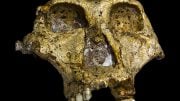



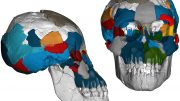
Wonderful how they knew the fossil ape was 8.7 million years old. sarc
The dating methods for these fossils are several. The surrounding geological strata, and biological strata are given absolute ages from potassium/argon decay studies, and paleomagnatism analysis. The ape fossils in question are too few, and too important to destroy for chemical analysis. So, the dates are used for the associated geology, and other surrounding fossils.
The dating methods for these fossils are several. The geological strata, and biological strata are given absolute ages from potassium/argon decay studies, and paleomagnatism analysis. The ape fossils in question are too few, and too important to destroy for chemical analysis. So, the dates are used for the associated geology, and other surrounding fossils.
the study’s authors – which also include colleagues at Ege University and Pamukkale University in Türkiye and the Naturalis Biodiversity Center in The Netherlands – conclude that the ancestors of both came from Europe and the eastern Mediterranean.”” – of course they going to deny anything worthy could come from Africa!!
It seems to me that you are the one assuming things about both them and their findings. You should wait till further studies appear. Not attack the messenger.
The fact that spirits exist proves what’s really in the world. And if you think there’s only the flesh and no spirits, I suggest you take a trip to Nigeria, Africa, and visit the annual Voodoo festival. There’s plenty of magic and spirit interaction there. The hoax is over.
I am glad that the authors have said that more study is needed. The lack of evidence does not disprove the alternative theory that humans originated in Africa. Europe does not need to be the origin of everything!!!!
It isn’t a question of what is needed. It’s a question of what can be proven.
This is not a fun paper, though it describes a discovery. The Peer Review file as well as the comments under the paper tells the story best. The 2nd referee still disagrees with the cladistic analysis after the process and stated at the outset that they would rather it hadn’t been included. And the comment [by GS Hurd here] notes that the popular press response has among others included nonscientific creationism superstition.
As a bioinformatician I don’t have the area knowledge of hominids and how skulls can be used to make cladistic claims on species. But I note that the software uses parsimony which is often generating erroneous trees, and the consensus tree support values are poor at the crucial branch including the new species and its relatives.
The tree is crucially the only support to say that early apes have reentered Africa. Without it the main hypothesis of an Africa origin fits the data best. Many branches, including early hominins, have migrated from Africa and either gone extinct or like gibbons and pongines survived in Asia.
To respond to comments here I would add/clarify:
The dating that several of these related European fossils have been recovered from the same period, see the paper, so the age estimate fits.
And the African origin of apes has been the uncontested main theory, supported by ever more data. It is other hypotheses that are alternative.
Typo: The dating of several…
I’m not sure if the Turkish Ministry of Culture and Tourism can be looked at as an objective source for studies like this. Time will tell. Soon enough. If on the off chance they are correct in a generation David Begun and Ayla Sevim Erol will be as famous in their field as Luis Alvarez in the field of mass planetary extinctions. When he first theorized it he was badly reviewed by his peers. Or Alfred Wegener who first theorized continental drift. That was laughed at at first too. But the Turkish Ministry of Culture and Tourism? Who knows. In 2053 we may know.
With so many hominids having existed on this planet I don’t understand why they keep doing this. It’s like they have no idea about evolution
The Biblical account is the correct account and will be manifest as research continues.
“the fools are confident and rage on with their theories” but the Biblical is eyewitness and reliable as archeology demonstrates. No apologies from those in error however.